Promotion of Welfare to Regular Employment (Community work support project for persons with disabilities)
This project was started in fiscal 2005 at 10 Hello Work offices across the nation with a view to supporting persons with disabilities achieve independence. It helps the transition of disabled people from welfare to regular employment, with the Hello Work offices playing the leading role and in close cooperation with relevant community organizations.
Project Outline
Assistance by community work support team for persons with disabilities
Persons with disabilities who are using welfare facilities and hope to obtain employment receive integrated support, covering a range of processes from preparations for work to settlement into the workplace, from “community work support teams.” The teams are established under the leadership of the Hello Work offices and composed of community supporters.
Work support program that combines welfare facility training (work) with practical training at companies
This program aims to ease disabled people's concerns related to employment and working life and to enhance their job readiness. It provides disabled people engaged in training (work) at welfare facilities with opportunities to receive practical training at companies one to three times per week while continuing in-facility training (work).
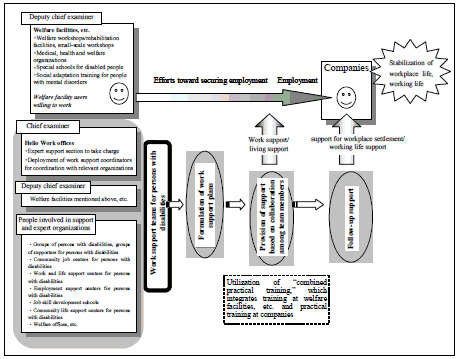
Use of "Trial Employment" to Create Employment Opportunities for Persons with Disabilities (Trial Employment Project for Persons with Disabilities)
Companies which have little experience of employing persons with disabilities but are willing to employ such people may hesitate to do so because of their lack of know-how for structuring jobs in ways suitable for the disabled and supervising their work.
On the other hand, people with disabilities, because of their lack of work experience, may be worried over what kind of jobs are suitable for them and whether they can endure the burden of work.
The trial employment project aims to address these problems by allowing companies to employ people with disabilities for a short term on a trial basis, an arrangement which may lead to the creation of jobs for the disabled and facilitate the transition from welfare to regular employment.
- Period: A maximum of 3 months (fixed-term employment contract to be concluded between the employer and the disabled person based on job introduction from the Hello Work office)
- Subsidies: The employer receives 50,000 per month for each person employed under the trial employment project.
- Number of persons employed under the project: 6,000 (fiscal 2006)
- Past records: 4,220 people newly employed under the system in fiscal 2004, with 82.8% shifted to regular employment
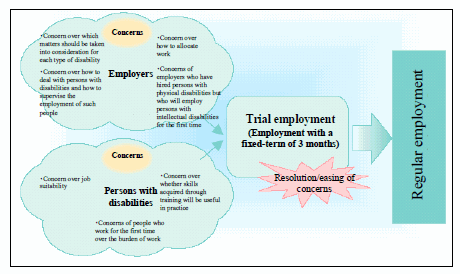
Assistance by Workplace Adaptation Supporters (Job Coaches)
Job coaches help persons with intellectual disabilities and mental disorders adapt to the workplace by providing individually-tailored support.
Job coaches are stationed at community job centers for persons with disabilities to be dispatched when necessary to provide support. Social welfare corporations with expertise in work support and employing companies may deploy job coaches by using subsidies for the job coach scheme.
Timing for Starting Support
- When being employed (Support to be started before or at the same time as the start of employment)
- When job adaptation problems occur due to change in the working environment, etc.
Contents of support
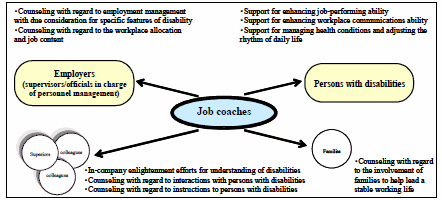
Standard flow of support

The number of job coaches deployed (as of the end of March 2006
A total of 703
The number of community center job coaches: 314
The number of job coaches stationed at welfare facilities (type 1): 377
The number of job coaches stationed at employing companies (type 2): 12
Past records (fiscal 2004, community centers)
The number of people covered by the job coach support scheme: 2,960
The workplace settlement rate (6 months after the end of support): 83.0%
Integrated Support Covering Work and Daily Life
(Project for Employment and Living Support Centers for Persons with Disabilities)
This project helps resolve problems faced by disabled people wishing to obtain employment and working persons with disabilities, under the collaboration of organizations involved in work support and welfare-related activities. Officials in charge of work support and those responsible for living support thus cooperate in providing integrated support with regard to issues related to both work and daily life. (This project started in fiscal 2002)
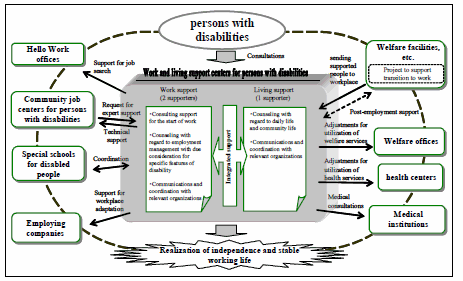
- * Contents of activities at work and life support centers for persons with disabilities
- The centers provide consultations to persons with disabilities who need support for their working and daily life and dispatch staff to their homes and workplaces.
Work support
- Support for preparations for starting work
- Support for job search
- Support for settling into the workplace
- Counseling to the employer with regard to employment management with due consideration for specific features of disability
- Communications and coordination with relevant organizations
Living support
- Counseling with regard to the formation of a life routine and self management of health, financial matters and daily life activities
- Counseling concerning the community life and life planning such as housing, pensions and leisure activities
- Communications and coordination with relevant organizations
- * The number of work and living support centers for persons with disabilities
- 90 in fiscal 2005 (110 in fiscal 2006)
Special Subsidiary System
Requirements for hiring persons with disabilities under the employment quota system must be met by each employer in principle. However, if an employer establishes a subsidiary which pays special consideration to the employment of persons with disabilities and which is recognized by the minister of health, labor and welfare (the heads of public security employment offices) as meeting certain requirements, employees hired by the subsidiary may be regarded as being employed by the parent company and included in the calculation of the actual employment rate for the parent.
For the parent company, the special subsidiary system thus contributes to the achievement of the employment quota for persons with disabilities, while the system is expected to expand opportunities for persons with disabilities to exercise their abilities to the full in a working environment created with due consideration for such people. Also, the parent company of such a special subsidiary may calculate the employment rate for the disabled as a corporate group, including figures for other affiliated firms.
Recognition Requirement
Parent company requirement
The parent company must hold control over the decision-making body (a general shareholders’ meeting, etc.) of its subsidiary.
Subsidiary requirements
- Parent-subsidiary relations must be close in terms of personnel exchange.
- The number of persons with disabilities employed must be five or more, and the ratio to the overall workforce must be 20% or higher. In addition, 30% or more of the persons with disabilities employed must be people with severe physical disabilities, intellectual disabilities or mental disorders.
- The subsidiary must be capable of properly supervising the employment of persons with disabilities.
- Recognition is granted when employment of persons with disabilities is expected to be promoted and secured.
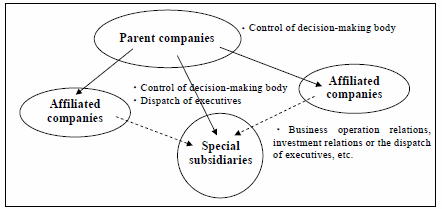
Support Scheme for Home-Working Persons with Disabilities
This scheme provides special adjustment funds and subsidies to companies which place business orders with persons with disabilities who are working at home.
Special adjustment funds and subsidiaries are also extended to companies which place orders to home-working persons with disabilities through home work support organizations (judicial persons registered as organizations supporting home-working persons with disabilities based on applications filed with the minister of health, labor and welfare).
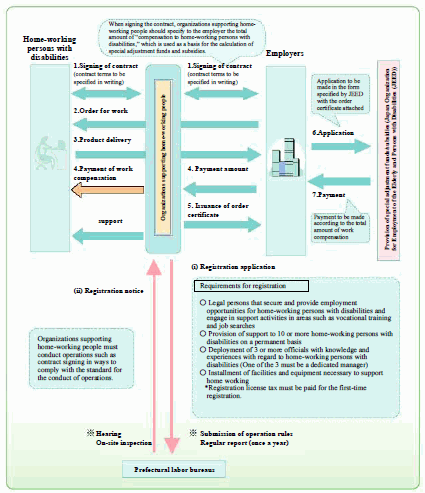
Employment Support at Special Schools for Persons with Disabilities
Special schools for people with disabilities are striving to enhance job training and guidance for post-graduation career choices.
Enhancement of Job Training Adapted to Social Change and Students’ Conditions
Advanced courses at special schools for the disabled provide a variety of job training programs adapted to students’ conditions, including lessons for specialist subjects related to jobs, thus playing an important role in helping students achieve independence and social participation after graduation.
At schools for the blind, for example, courses related to massage, acupuncture, moxibustion and physical therapy are available to enable students to obtain the necessary qualifications, while at schools for the deaf, courses related to hairdressing and dental technician work are available.
Also, in response to social change, a specialist course on “distribution and services” was created at schools for people with intellectual disabilities to help obtain employment in the tertiary industry. Furthermore, schools for the disabled are utilizing computers and information and communications networks and trying to expand opportunities for students to gain working experience in cooperation with the industry.
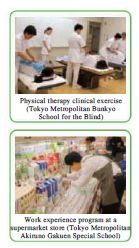
Promotion of Workplace Training at Companies
Workplace practical training at companies is important and is actively adopted by schools for the disabled as it develops the students’ view of jobs and labor and facilitates their transition from school life to life in society.
In order to promote workplace training, the Ministry of Education, Culture, Sports, Science and Technology provides subsidies for secondary and advanced courses at schools for the disabled and special classes at secondary schools to cover transport and lodging expenses related to such training (only transport expenses in the case of secondary school special classes). Also, the Ministry of Health, Labour and Welfare is promoting workplace training by establishing a subsidy scheme for group work training (work-place training type).
Collaboration with Labor-Related Organizations, etc.
In order to enhance job training and guidance for post-graduation career choices, special schools for the disabled draw up individualized education programs and provide support in cooperation with labor-related organizations such as public employment security offices and community job centers for persons with disabilities as well as medical and welfare institutions, etc.
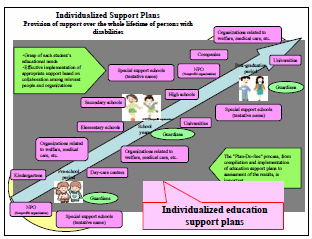
Reference Data
Status of children and persons with disabilities
Unit: People
| Classification | Total number | Home-working people | People at facilities |
|---|---|---|---|
| Children and persons with physical disabilities | 3,516,000 | 3,327,000 | 189,000 |
| Children with physical disabilities (aged less than 18) | 90,000 | 82,000 | 8,000 |
| Persons with physical disabilities (aged 18 or older) | 3,426,000 | 3,245,000 | 181,000 |
| Children and persons with intellectual disabilities | 459,000 | 329,000 | 130,000 |
| Children with intellectual disabilities (aged less than 18) | 103,000 | 94,000 | 9,000 |
| Persons with intellectual disabilities (aged 18 or older) | 342,000 | 221,000 | 121,000 |
| Age unknown | 14,000 | 14,000 | 0 |
| Persons with mental disorders | 2,584,000 | 2,239,000 | 345,000 |
| Aged less than 20 | 142,000 | 139,000 | 3,000 |
| Aged 20 or older | 2,436,000 | 2,095,000 | 341,000 |
| Age unknown | 6,000 | 5,000 | 1,000 |
Source: Ministry of Health, Labour and Welfare
The number of children studying at special schools for disabled people and children receiving education in special classes and Tsukyu (Resource Room)
Unit: People
| Schools for the blind | Schools for the deaf | Schools for the other disabled | Elementary and lower secondary schools | Total | |
|---|---|---|---|---|---|
| Special classes | Tsukyu (Resource Room) | ||||
| 3,809 | 6,639 | 91,164 | 96,811 | 38,738 | 237,161 |
(As of May 1, 2005)
Source: Ministry of Education, Culture, Sports, Science and Technology
Status of Employment of Persons with Disabilities
1. Status of employment of persons with disabilities by private-sector companies by workforce size
(as of June 1, 2005)
| Classification | (1) No. of companies | (2) No. of regular workers | (3) No. of persons with disabilities | (4) Actual employment rate | (5) No. of companies meeting employment quota | (6) Ratio of entities meeting employment quota | ||
|---|---|---|---|---|---|---|---|---|
| (A) Persons with severe disabilities (regular workers) | (B) Disabled persons other than those with severe disabilities employed on a regular basis | (c) (A) x 2 + (B) | ||||||
| people | companies | people | people | people | people | % | companies | % |
| 58 to99 | 24,361(24,009) | 1,795,317(1,766,099) | 6,201(6,178) | 13,769(13,406) | 26,171(25,762) | 1.46(1.46) | 10,835(10,638) | 44.5(44.3) |
| 100 to299 | 29,323(28,432) | 4,426,269(4,287,080) | 13,006(12,633) | 29,000(28,114) | 55,012(53,380) | 1.24(1.25) | 12,447(12,104) | 42.4(42.6) |
| 300 to499 | 5,449(5,307) | 1,888,166(1,833,105) | 7,169(6,793) | 13,180(12,731) | 27,518(26,317) | 1.46(1.44) | 2,138(1,997) | 39.2(37.6) |
| 500 to999 | 3,705(3,659) | 2,339,966(2,300,290) | 9,261(8,858) | 16,047(15,416) | 24,569(33,132) | 1.48(1.44) | 1,288(1,168) | 34.8(31.9) |
| 1,000 or more | 2,611(2,586) | 7,642,153(7,480,732) | 36,041(34,077) | 53,714(51,194) | 125,796(119,348) | 1.65(1.60) | 869(759) | 33.3(29.4) |
| Total | 65,449(63,993) | 18,091,871(17,667,306) | 71,678(68,539) | 125,710(120,861) | 269,066(257,939) | 1.49(1.46) | 27,577(26,666) | 42.1(41.7) |
- Note
-
- The number of regular workers as mentioned above is the total number of permanent workers minus the number attained by multiplying with a prescribed rate the number of workers in industries that involves a fairly large proportion of jobs for which it is deemed to be difficult to employ persons with disabilities. This number is used as a basis for the calculation of the mandatory employment quota for persons with disabilities.
- "Persons with disabilities (regular workers)" in column A do not include short-hours workers. "Disabled persons other than those with severe disabilities (regular workers)" in column B include disabled persons working for short hours.
- The number of persons with disabilities represents the total of persons with physical disabilities and those with intellectual disabilities. With regard to people with severe physical or intellectual disabilities included in column A, one person is counted as two according to law provisions.
- Figures in parentheses represent those as of June 1, 2004.
2. Status of employment of persons with disabilities at central and local governments.
(1) Central and local government bodies to which employment quota ratio of 2.1% is applied
(as of June 1, 2005)
| Classification | (1) No. of companies | (2) No. of employees | (3) No. of persons with disabilities | (4) Actual employment rate | (5) No. of entities meeting employment quota | (6) Ratio of entities meeting employment quota | ||
|---|---|---|---|---|---|---|---|---|
| (A) Persons with severe disabilities (regular workers) | (B) Disabled persons other than those with severe disabilities employed on a regular basis | (c) (A) x 2 + (B) | ||||||
| people | entities | people | people | people | people | % | entities | % |
| Central government entities | 43(43) | 303,432(303,269) | 843(861) | 4,810(4,811) | 6,496(6,533) | 2.14(2.15) | 37(37) | 86.0(86.0) |
| Prefectural government entities | 156(157) | 355,482(363,070) | 2,035(1,996) | 4,248(4,294) | 8,318(8,286) | 2.34(2.28) | 136(129) | 87.2(82.2) |
| Municipal government entities | 3,771(3,813) | 986,517(993,557) | 5,495(5,454) | 10,829(10,965) | 21,819(21,873) | 2.21(2.20) | 2,902(2,928) | 77.0(76.8) |
| Total | 3,970(4,013) | 1,645,431(1,659,896) | 8,373(8,311) | 19,887(20,070) | 36,633(36,692) | 2.23(2.21) | 3,075(3,094) | 77.5(77.1) |
(2) Education boards of prefectures, etc. to which employment quota ratio of 2.0% is applied
(as of June 1, 2005)
| Classification | (1) No. of companies | (2) No. of employees | (3) No. of persons with disabilities | (4) Actual employment rate | (5) No. of entities meeting employment quota | (6) Ratio of entities meeting employment quota | ||
|---|---|---|---|---|---|---|---|---|
| (A) Persons with severe disabilities (regular workers) | (B) Disabled persons other than those with severe disabilities employed on a regular basis | (c) (A) x 2 + (B) | ||||||
| people | entities | people | people | people | people | % | entities | % |
| Board of education | 134(134) | 670,333(673,511) | 2,524(2,413) | 4,269(4,130) | 9,317(8,956) | 1.39(1.33) | 65(66) | 48.5(49.3) |
- Note
-
- The number of employees as mentioned above is the total employee number minus the number of employees designated to be excluded, and is used as a basis for the calculation of the mandatory employment quota.
- "Persons with disabilities (regular workers)" in column A do not include short-hours workers. "Disabled persons other than those with severe disabilities (regular workers)" in column B include disabled persons working for short hours.
- The number of persons with disabilities represents the total of persons with physical disabilities and those with intellectual disabilities. With regard to people with severe physical or intellectual disabilities included in column A, one person is counted as two according to law provisions.
- Organizations to which the employment quota ratio of 2.0% is applied comprise education boards of prefectures and designated municipalities.
- The employment quota ratio of 2.1% is applied to organizations other than those mentioned in Note 4.
- Figures in parentheses indicate those as of June 1, 2004
Source: Ministry of Health, Labour and Welfare
